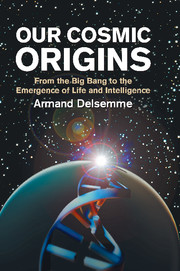Book contents
- Frontmatter
- Contents
- Foreword
- Preface
- Acknowledgments
- 1 Locating humans in the Universe
- 2 The race toward complexity
- 3 The stellar alchemy of metals
- 4 The formation of the planets
- 5 The emergence of life
- 6 The history of life
- 7 The awakening of intelligence
- 8 The other worlds
- 9 Perspectives
- APPENDIX A The standard model of the physics of elementary particles
- APPENDIX B Symmetry in physics
- APPENDIX C The strange role of time in relativity
- APPENDIX D The measurement of long time spans and the age of the Universe
- APPENDIX E The standard model of the Big Bang
- APPENDIX F The cause of the Big Bang and inflation
- APPENDIX G Chirality
- Glossary
- Bibliography
- Figure index
- Table index
- Name index
- Subject index
APPENDIX A - The standard model of the physics of elementary particles
Published online by Cambridge University Press: 05 August 2012
- Frontmatter
- Contents
- Foreword
- Preface
- Acknowledgments
- 1 Locating humans in the Universe
- 2 The race toward complexity
- 3 The stellar alchemy of metals
- 4 The formation of the planets
- 5 The emergence of life
- 6 The history of life
- 7 The awakening of intelligence
- 8 The other worlds
- 9 Perspectives
- APPENDIX A The standard model of the physics of elementary particles
- APPENDIX B Symmetry in physics
- APPENDIX C The strange role of time in relativity
- APPENDIX D The measurement of long time spans and the age of the Universe
- APPENDIX E The standard model of the Big Bang
- APPENDIX F The cause of the Big Bang and inflation
- APPENDIX G Chirality
- Glossary
- Bibliography
- Figure index
- Table index
- Name index
- Subject index
Summary
Matter is made up of two kinds of elementary particle, quarks and leptons, each having six varieties divided into two groups of three:
Quarks
up, charmed, top (all three have charge +2/3;)
down, strange, bottom (all three have charge -1/3;)
Leptons
electron, muon, tauon (all three have charge -1)
neutrinoe, neutrinoμ, neutrinoτ (all three have charge 0).
The three neutrinos are not interchangeable; they are distinguished by indices
Usual matter
matter we are familiar with is made up only of:
the up quark, the down quark, and the electron; in particular:
the proton is made up of three quarks: up, up, down (charge +1),
the neutron is made up of three quarks: up, down, down (charge 0).
Mesons
elusive particles made of 1 quark and 1 antiquark; the 6 types of quarks make 36 types of mesons.
Forces of nature
Four types of force of different symmetries occur among matter particles; these forces are carried by particles of a new kind:
(1) electromagnetism, carried by the photon (light, X-rays, γ rays, etc.)
(2) the weak force is carried by three particles: W+, W- and Z0
(3) the strong force is carried by eight ‘colors’ of gluons
(4) gravitation is carried by the graviton
The standard model unifies electromagnetism and the weak force, as if the three particles W+, W- and Z0 were actually heavy photons.
The existence of the top quark had been predicted for a score of years; it was finally observed in 1994, completing the list of elementary particles.
- Type
- Chapter
- Information
- Our Cosmic OriginsFrom the Big Bang to the Emergence of Life and Intelligence, pp. 277 - 278Publisher: Cambridge University PressPrint publication year: 1998



